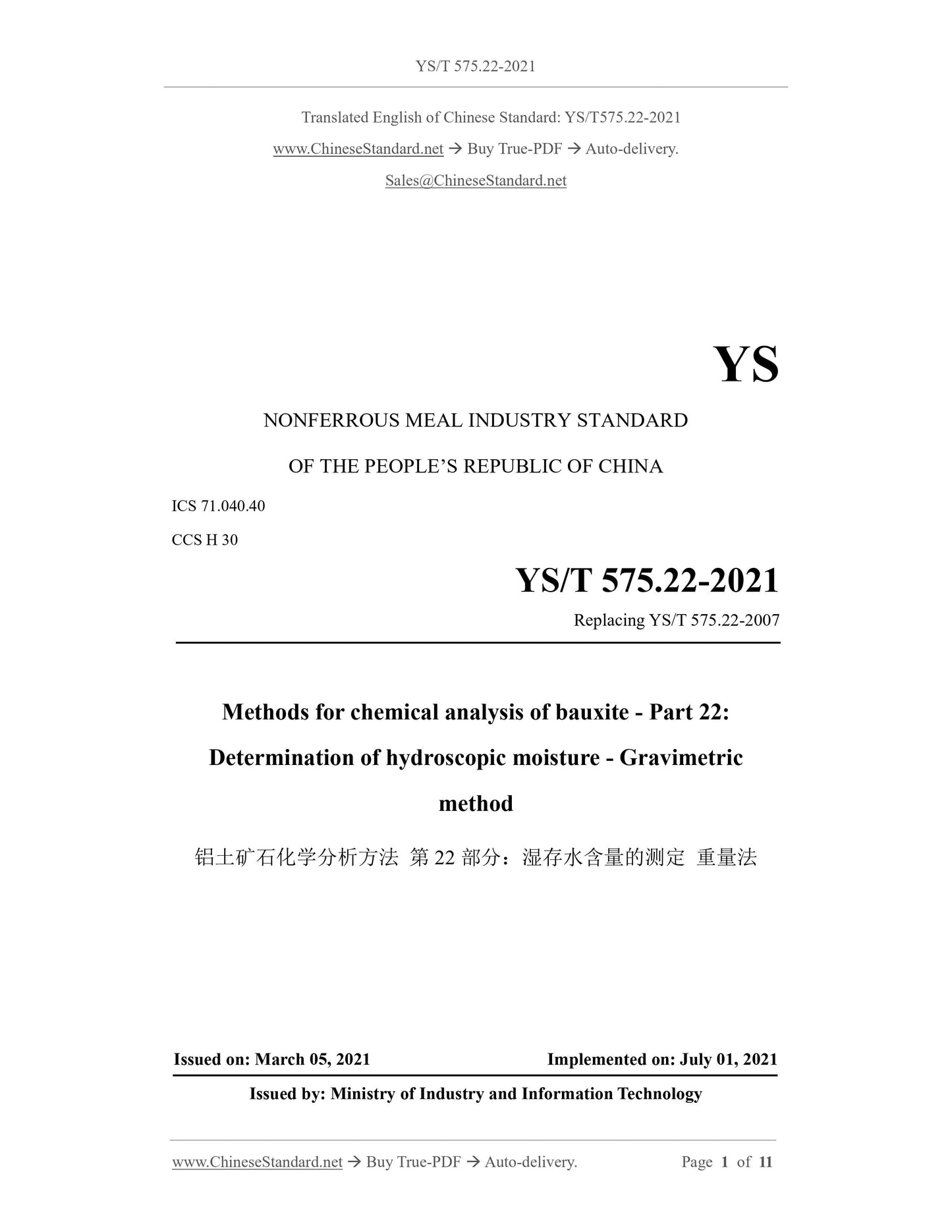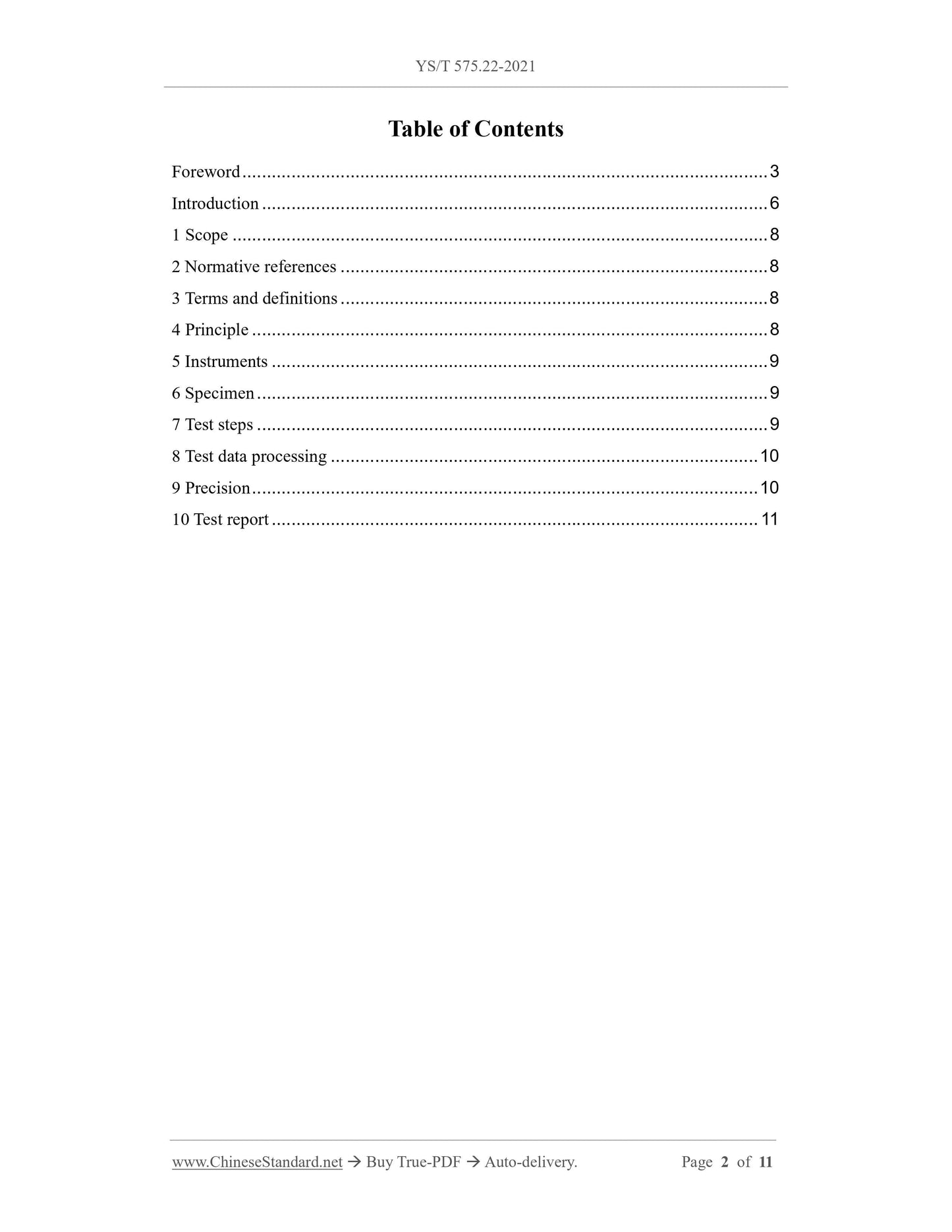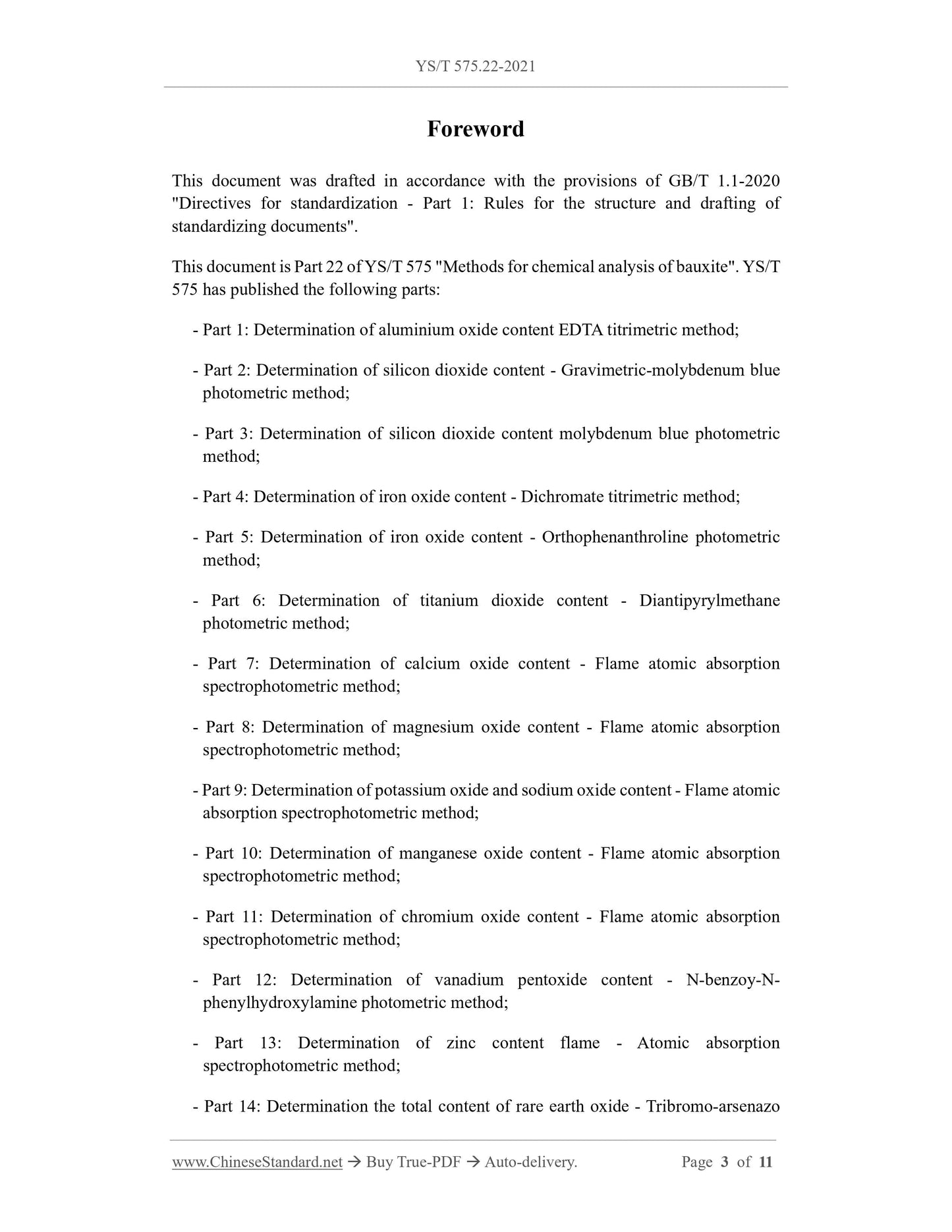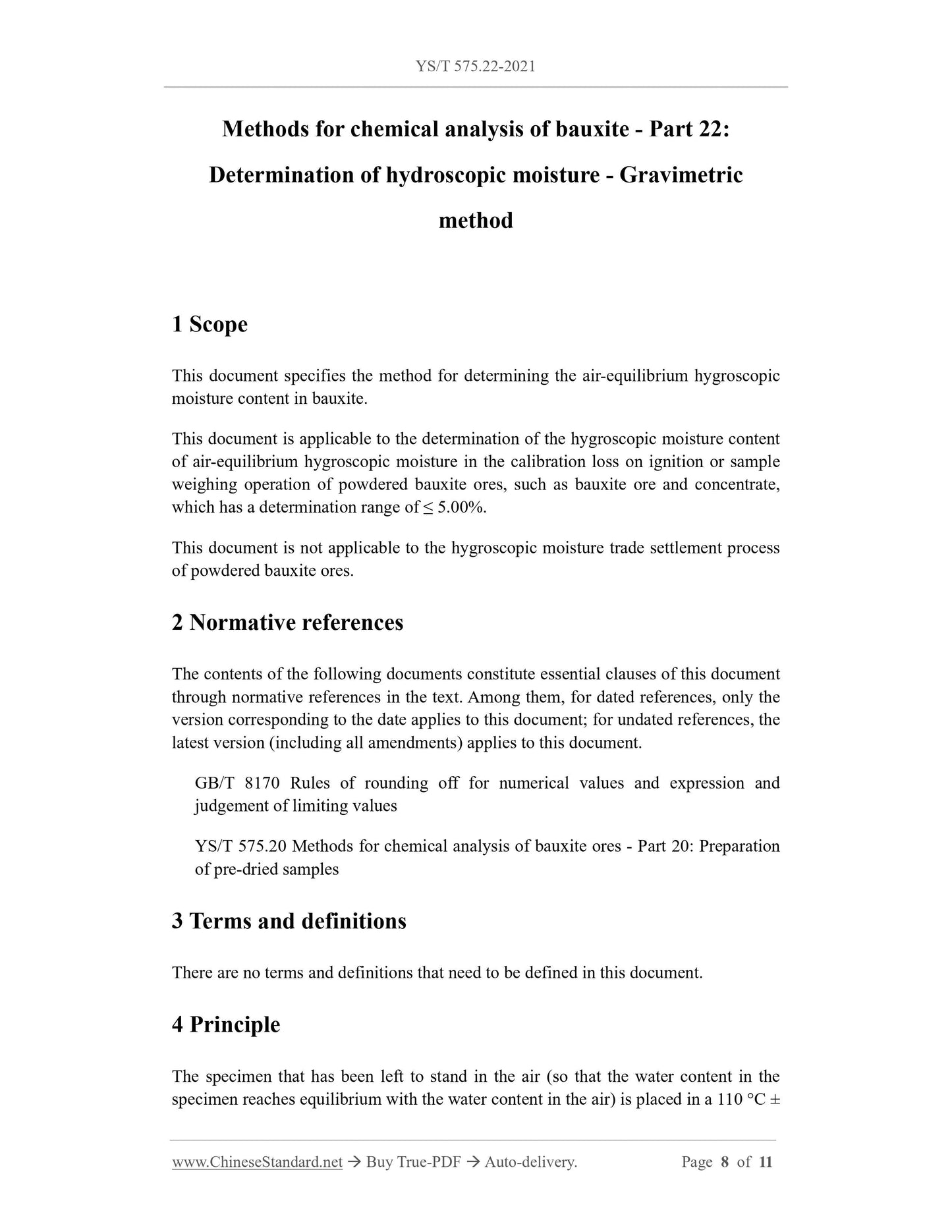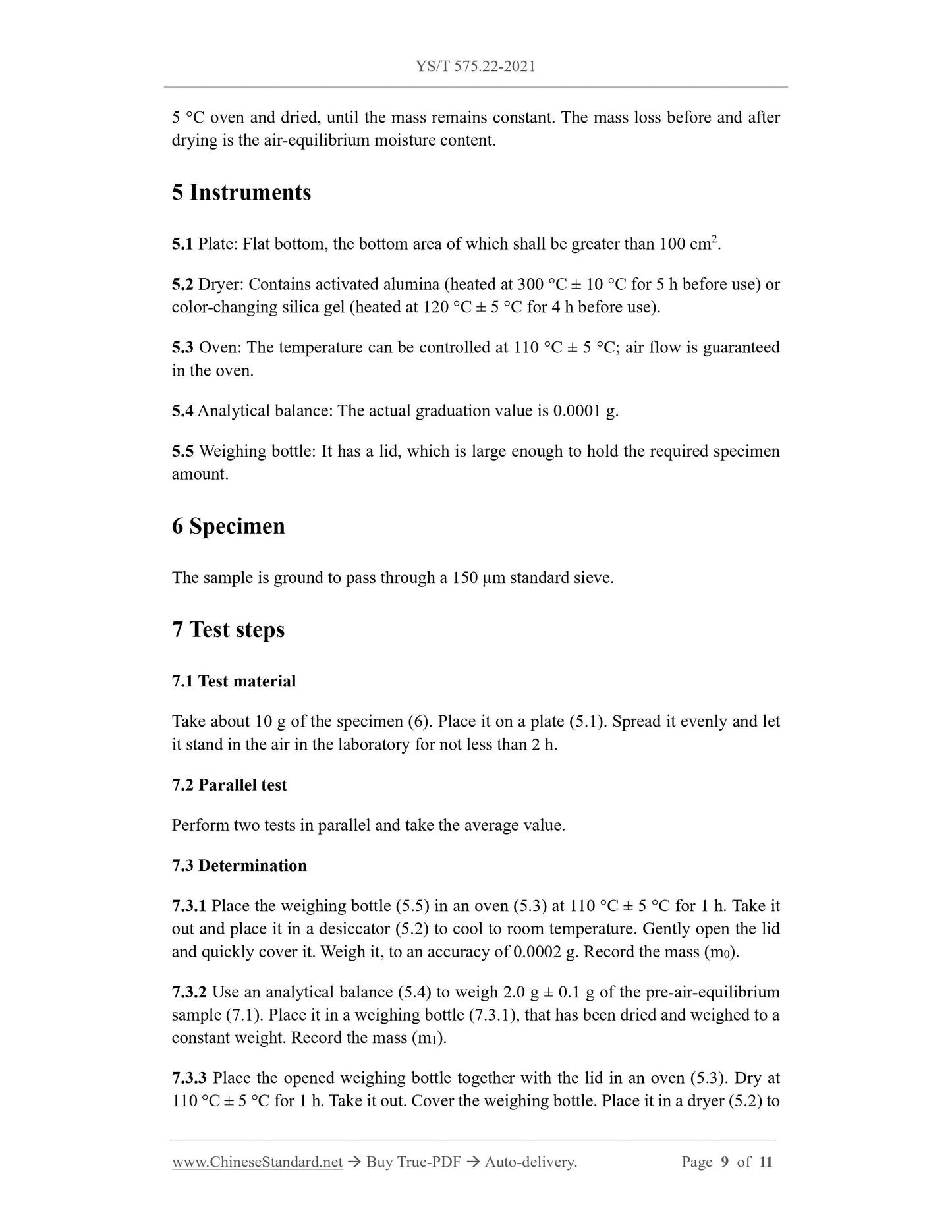1
/
of
5
www.ChineseStandard.us -- Field Test Asia Pte. Ltd.
YS/T 575.22-2021 English PDF (YS/T575.22-2021)
YS/T 575.22-2021 English PDF (YS/T575.22-2021)
Regular price
$190.00
Regular price
Sale price
$190.00
Unit price
/
per
Shipping calculated at checkout.
Couldn't load pickup availability
YS/T 575.22-2021: Methods for chemical analysis of bauxite - Part 22: Determination of hydroscopic moisture - Gravimetric method
Delivery: 9 seconds. Download (& Email) true-PDF + Invoice.
Get Quotation: Click YS/T 575.22-2021 (Self-service in 1-minute)
Historical versions (Master-website): YS/T 575.22-2021
Preview True-PDF (Reload/Scroll-down if blank)
YS/T 575.22-2021
YS
NONFERROUS MEAL INDUSTRY STANDARD
OF THE PEOPLE’S REPUBLIC OF CHINA
ICS 71.040.40
CCS H 30
Replacing YS/T 575.22-2007
Methods for chemical analysis of bauxite - Part 22:
Determination of hydroscopic moisture - Gravimetric
method
ISSUED ON: MARCH 05, 2021
IMPLEMENTED ON: JULY 01, 2021
Issued by: Ministry of Industry and Information Technology
Table of Contents
Foreword ... 3
Introduction ... 6
1 Scope ... 8
2 Normative references ... 8
3 Terms and definitions ... 8
4 Principle ... 8
5 Instruments ... 9
6 Specimen ... 9
7 Test steps ... 9
8 Test data processing ... 10
9 Precision ... 10
10 Test report ... 11
Foreword
This document was drafted in accordance with the provisions of GB/T 1.1-2020
"Directives for standardization - Part 1: Rules for the structure and drafting of
standardizing documents".
This document is Part 22 of YS/T 575 "Methods for chemical analysis of bauxite". YS/T
575 has published the following parts:
- Part 1: Determination of aluminium oxide content EDTA titrimetric method;
- Part 2: Determination of silicon dioxide content - Gravimetric-molybdenum blue
photometric method;
- Part 3: Determination of silicon dioxide content molybdenum blue photometric
method;
- Part 4: Determination of iron oxide content - Dichromate titrimetric method;
- Part 5: Determination of iron oxide content - Orthophenanthroline photometric
method;
- Part 6: Determination of titanium dioxide content - Diantipyrylmethane
photometric method;
- Part 7: Determination of calcium oxide content - Flame atomic absorption
spectrophotometric method;
- Part 8: Determination of magnesium oxide content - Flame atomic absorption
spectrophotometric method;
- Part 9: Determination of potassium oxide and sodium oxide content - Flame atomic
absorption spectrophotometric method;
- Part 10: Determination of manganese oxide content - Flame atomic absorption
spectrophotometric method;
- Part 11: Determination of chromium oxide content - Flame atomic absorption
spectrophotometric method;
- Part 12: Determination of vanadium pentoxide content - N-benzoy-N-
phenylhydroxylamine photometric method;
- Part 13: Determination of zinc content flame - Atomic absorption
spectrophotometric method;
- Part 14: Determination the total content of rare earth oxide - Tribromo-arsenazo
Methods for chemical analysis of bauxite - Part 22:
Determination of hydroscopic moisture - Gravimetric
method
1 Scope
This document specifies the method for determining the air-equilibrium hygroscopic
moisture content in bauxite.
This document is applicable to the determination of the hygroscopic moisture content
of air-equilibrium hygroscopic moisture in the calibration loss on ignition or sample
weighing operation of powdered bauxite ores, such as bauxite ore and concentrate,
which has a determination range of ≤ 5.00%.
This document is not applicable to the hygroscopic moisture trade settlement process
of powdered bauxite ores.
2 Normative references
The contents of the following documents constitute essential clauses of this document
through normative references in the text. Among them, for dated references, only the
version corresponding to the date applies to this document; for undated references, the
latest version (including all amendments) applies to this document.
GB/T 8170 Rules of rounding off for numerical values and expression and
judgement of limiting values
YS/T 575.20 Methods for chemical analysis of bauxite ores - Part 20: Preparation
of pre-dried samples
3 Terms and definitions
There are no terms and definitions that need to be defined in this document.
4 Principle
The specimen that has been left to stand in the air (so that the water content in the
specimen reaches equilibrium with the water content in the air) is placed in a 110 °C ±
5 °C oven and dried, until the mass remains constant. The mass loss before and after
drying is the air-equilibrium moisture content.
5 Instruments
5.1 Plate: Flat bottom, the bottom area of which shall be greater than 100 cm2.
5.2 Dryer: Contains activated alumina (heated at 300 °C ± 10 °C for 5 h before use) or
color-changing silica gel (heated at 120 °C ± 5 °C for 4 h before use).
5.3 Oven: The temperature can be controlled at 110 °C ± 5 °C; air flow is guaranteed
in the oven.
5.4 Analytical balance: The actual graduation value is 0.0001 g.
5.5 Weighing bottle: It has a lid, which is large enough to hold the required specimen
amount.
6 Specimen
The sample is ground to pass through a 150 μm standard sieve.
7 Test steps
7.1 Test material
Take about 10 g of the specimen (6). Place it on a plate (5.1). Spread it evenly and let
it stand in the air in the laboratory for not less than 2 h.
7.2 Parallel test
Perform two tests in parallel and take the average value.
7.3 Determination
7.3.1 Place the weighing bottle (5.5) in an oven (5.3) at 110 °C ± 5 °C for 1 h. Take it
out and place it in a desiccator (5.2) to cool to room temperature. Gently open the lid
and quickly cover it. Weigh it, to an accuracy of 0.0002 g. Record the mass (m0).
7.3.2 Use an analytical balance (5.4) to weigh 2.0 g ± 0.1 g of the pre-air-equilibrium
sample (7.1). Place it in a weighing bottle (7.3.1), that has been dried and weighed to a
constant weight. Record the mass (m1).
7.3.3 Place the opened weighing bottle together with the lid in an oven (5.3). Dry at
110 °C ± 5 °C for 1 h. Take it out. Cover the weighing bottle. Place it in a dryer (5.2) to
YS/T 575.22-2021
YS
NONFERROUS MEAL INDUSTRY STANDARD
OF THE PEOPLE’S REPUBLIC OF CHINA
ICS 71.040.40
CCS H 30
Replacing YS/T 575.22-2007
Methods for chemical analysis of bauxite - Part 22:
Determination of hydroscopic moisture - Gravimetric
method
ISSUED ON: MARCH 05, 2021
IMPLEMENTED ON: JULY 01, 2021
Issued by: Ministry of Industry and Information Technology
Table of Contents
Foreword ... 3
Introduction ... 6
1 Scope ... 8
2 Normative references ... 8
3 Terms and definitions ... 8
4 Principle ... 8
5 Instruments ... 9
6 Specimen ... 9
7 Test steps ... 9
8 Test data processing ... 10
9 Precision ... 10
10 Test report ... 11
Foreword
This document was drafted in accordance with the provisions of GB/T 1.1-2020
"Directives for standardization - Part 1: Rules for the structure and drafting of
standardizing documents".
This document is Part 22 of YS/T 575 "Methods for chemical analysis of bauxite". YS/T
575 has published the following parts:
- Part 1: Determination of aluminium oxide content EDTA titrimetric method;
- Part 2: Determination of silicon dioxide content - Gravimetric-molybdenum blue
photometric method;
- Part 3: Determination of silicon dioxide content molybdenum blue photometric
method;
- Part 4: Determination of iron oxide content - Dichromate titrimetric method;
- Part 5: Determination of iron oxide content - Orthophenanthroline photometric
method;
- Part 6: Determination of titanium dioxide content - Diantipyrylmethane
photometric method;
- Part 7: Determination of calcium oxide content - Flame atomic absorption
spectrophotometric method;
- Part 8: Determination of magnesium oxide content - Flame atomic absorption
spectrophotometric method;
- Part 9: Determination of potassium oxide and sodium oxide content - Flame atomic
absorption spectrophotometric method;
- Part 10: Determination of manganese oxide content - Flame atomic absorption
spectrophotometric method;
- Part 11: Determination of chromium oxide content - Flame atomic absorption
spectrophotometric method;
- Part 12: Determination of vanadium pentoxide content - N-benzoy-N-
phenylhydroxylamine photometric method;
- Part 13: Determination of zinc content flame - Atomic absorption
spectrophotometric method;
- Part 14: Determination the total content of rare earth oxide - Tribromo-arsenazo
Methods for chemical analysis of bauxite - Part 22:
Determination of hydroscopic moisture - Gravimetric
method
1 Scope
This document specifies the method for determining the air-equilibrium hygroscopic
moisture content in bauxite.
This document is applicable to the determination of the hygroscopic moisture content
of air-equilibrium hygroscopic moisture in the calibration loss on ignition or sample
weighing operation of powdered bauxite ores, such as bauxite ore and concentrate,
which has a determination range of ≤ 5.00%.
This document is not applicable to the hygroscopic moisture trade settlement process
of powdered bauxite ores.
2 Normative references
The contents of the following documents constitute essential clauses of this document
through normative references in the text. Among them, for dated references, only the
version corresponding to the date applies to this document; for undated references, the
latest version (including all amendments) applies to this document.
GB/T 8170 Rules of rounding off for numerical values and expression and
judgement of limiting values
YS/T 575.20 Methods for chemical analysis of bauxite ores - Part 20: Preparation
of pre-dried samples
3 Terms and definitions
There are no terms and definitions that need to be defined in this document.
4 Principle
The specimen that has been left to stand in the air (so that the water content in the
specimen reaches equilibrium with the water content in the air) is placed in a 110 °C ±
5 °C oven and dried, until the mass remains constant. The mass loss before and after
drying is the air-equilibrium moisture content.
5 Instruments
5.1 Plate: Flat bottom, the bottom area of which shall be greater than 100 cm2.
5.2 Dryer: Contains activated alumina (heated at 300 °C ± 10 °C for 5 h before use) or
color-changing silica gel (heated at 120 °C ± 5 °C for 4 h before use).
5.3 Oven: The temperature can be controlled at 110 °C ± 5 °C; air flow is guaranteed
in the oven.
5.4 Analytical balance: The actual graduation value is 0.0001 g.
5.5 Weighing bottle: It has a lid, which is large enough to hold the required specimen
amount.
6 Specimen
The sample is ground to pass through a 150 μm standard sieve.
7 Test steps
7.1 Test material
Take about 10 g of the specimen (6). Place it on a plate (5.1). Spread it evenly and let
it stand in the air in the laboratory for not less than 2 h.
7.2 Parallel test
Perform two tests in parallel and take the average value.
7.3 Determination
7.3.1 Place the weighing bottle (5.5) in an oven (5.3) at 110 °C ± 5 °C for 1 h. Take it
out and place it in a desiccator (5.2) to cool to room temperature. Gently open the lid
and quickly cover it. Weigh it, to an accuracy of 0.0002 g. Record the mass (m0).
7.3.2 Use an analytical balance (5.4) to weigh 2.0 g ± 0.1 g of the pre-air-equilibrium
sample (7.1). Place it in a weighing bottle (7.3.1), that has been dried and weighed to a
constant weight. Record the mass (m1).
7.3.3 Place the opened weighing bottle together with the lid in an oven (5.3). Dry at
110 °C ± 5 °C for 1 h. Take it out. Cover the weighing bottle. Place it in a dryer (5.2) to
Delivery: 9 seconds. Download (& Email) true-PDF + Invoice.
Get Quotation: Click YS/T 575.22-2021 (Self-service in 1-minute)
Historical versions (Master-website): YS/T 575.22-2021
Preview True-PDF (Reload/Scroll-down if blank)
YS/T 575.22-2021
YS
NONFERROUS MEAL INDUSTRY STANDARD
OF THE PEOPLE’S REPUBLIC OF CHINA
ICS 71.040.40
CCS H 30
Replacing YS/T 575.22-2007
Methods for chemical analysis of bauxite - Part 22:
Determination of hydroscopic moisture - Gravimetric
method
ISSUED ON: MARCH 05, 2021
IMPLEMENTED ON: JULY 01, 2021
Issued by: Ministry of Industry and Information Technology
Table of Contents
Foreword ... 3
Introduction ... 6
1 Scope ... 8
2 Normative references ... 8
3 Terms and definitions ... 8
4 Principle ... 8
5 Instruments ... 9
6 Specimen ... 9
7 Test steps ... 9
8 Test data processing ... 10
9 Precision ... 10
10 Test report ... 11
Foreword
This document was drafted in accordance with the provisions of GB/T 1.1-2020
"Directives for standardization - Part 1: Rules for the structure and drafting of
standardizing documents".
This document is Part 22 of YS/T 575 "Methods for chemical analysis of bauxite". YS/T
575 has published the following parts:
- Part 1: Determination of aluminium oxide content EDTA titrimetric method;
- Part 2: Determination of silicon dioxide content - Gravimetric-molybdenum blue
photometric method;
- Part 3: Determination of silicon dioxide content molybdenum blue photometric
method;
- Part 4: Determination of iron oxide content - Dichromate titrimetric method;
- Part 5: Determination of iron oxide content - Orthophenanthroline photometric
method;
- Part 6: Determination of titanium dioxide content - Diantipyrylmethane
photometric method;
- Part 7: Determination of calcium oxide content - Flame atomic absorption
spectrophotometric method;
- Part 8: Determination of magnesium oxide content - Flame atomic absorption
spectrophotometric method;
- Part 9: Determination of potassium oxide and sodium oxide content - Flame atomic
absorption spectrophotometric method;
- Part 10: Determination of manganese oxide content - Flame atomic absorption
spectrophotometric method;
- Part 11: Determination of chromium oxide content - Flame atomic absorption
spectrophotometric method;
- Part 12: Determination of vanadium pentoxide content - N-benzoy-N-
phenylhydroxylamine photometric method;
- Part 13: Determination of zinc content flame - Atomic absorption
spectrophotometric method;
- Part 14: Determination the total content of rare earth oxide - Tribromo-arsenazo
Methods for chemical analysis of bauxite - Part 22:
Determination of hydroscopic moisture - Gravimetric
method
1 Scope
This document specifies the method for determining the air-equilibrium hygroscopic
moisture content in bauxite.
This document is applicable to the determination of the hygroscopic moisture content
of air-equilibrium hygroscopic moisture in the calibration loss on ignition or sample
weighing operation of powdered bauxite ores, such as bauxite ore and concentrate,
which has a determination range of ≤ 5.00%.
This document is not applicable to the hygroscopic moisture trade settlement process
of powdered bauxite ores.
2 Normative references
The contents of the following documents constitute essential clauses of this document
through normative references in the text. Among them, for dated references, only the
version corresponding to the date applies to this document; for undated references, the
latest version (including all amendments) applies to this document.
GB/T 8170 Rules of rounding off for numerical values and expression and
judgement of limiting values
YS/T 575.20 Methods for chemical analysis of bauxite ores - Part 20: Preparation
of pre-dried samples
3 Terms and definitions
There are no terms and definitions that need to be defined in this document.
4 Principle
The specimen that has been left to stand in the air (so that the water content in the
specimen reaches equilibrium with the water content in the air) is placed in a 110 °C ±
5 °C oven and dried, until the mass remains constant. The mass loss before and after
drying is the air-equilibrium moisture content.
5 Instruments
5.1 Plate: Flat bottom, the bottom area of which shall be greater than 100 cm2.
5.2 Dryer: Contains activated alumina (heated at 300 °C ± 10 °C for 5 h before use) or
color-changing silica gel (heated at 120 °C ± 5 °C for 4 h before use).
5.3 Oven: The temperature can be controlled at 110 °C ± 5 °C; air flow is guaranteed
in the oven.
5.4 Analytical balance: The actual graduation value is 0.0001 g.
5.5 Weighing bottle: It has a lid, which is large enough to hold the required specimen
amount.
6 Specimen
The sample is ground to pass through a 150 μm standard sieve.
7 Test steps
7.1 Test material
Take about 10 g of the specimen (6). Place it on a plate (5.1). Spread it evenly and let
it stand in the air in the laboratory for not less than 2 h.
7.2 Parallel test
Perform two tests in parallel and take the average value.
7.3 Determination
7.3.1 Place the weighing bottle (5.5) in an oven (5.3) at 110 °C ± 5 °C for 1 h. Take it
out and place it in a desiccator (5.2) to cool to room temperature. Gently open the lid
and quickly cover it. Weigh it, to an accuracy of 0.0002 g. Record the mass (m0).
7.3.2 Use an analytical balance (5.4) to weigh 2.0 g ± 0.1 g of the pre-air-equilibrium
sample (7.1). Place it in a weighing bottle (7.3.1), that has been dried and weighed to a
constant weight. Record the mass (m1).
7.3.3 Place the opened weighing bottle together with the lid in an oven (5.3). Dry at
110 °C ± 5 °C for 1 h. Take it out. Cover the weighing bottle. Place it in a dryer (5.2) to
YS/T 575.22-2021
YS
NONFERROUS MEAL INDUSTRY STANDARD
OF THE PEOPLE’S REPUBLIC OF CHINA
ICS 71.040.40
CCS H 30
Replacing YS/T 575.22-2007
Methods for chemical analysis of bauxite - Part 22:
Determination of hydroscopic moisture - Gravimetric
method
ISSUED ON: MARCH 05, 2021
IMPLEMENTED ON: JULY 01, 2021
Issued by: Ministry of Industry and Information Technology
Table of Contents
Foreword ... 3
Introduction ... 6
1 Scope ... 8
2 Normative references ... 8
3 Terms and definitions ... 8
4 Principle ... 8
5 Instruments ... 9
6 Specimen ... 9
7 Test steps ... 9
8 Test data processing ... 10
9 Precision ... 10
10 Test report ... 11
Foreword
This document was drafted in accordance with the provisions of GB/T 1.1-2020
"Directives for standardization - Part 1: Rules for the structure and drafting of
standardizing documents".
This document is Part 22 of YS/T 575 "Methods for chemical analysis of bauxite". YS/T
575 has published the following parts:
- Part 1: Determination of aluminium oxide content EDTA titrimetric method;
- Part 2: Determination of silicon dioxide content - Gravimetric-molybdenum blue
photometric method;
- Part 3: Determination of silicon dioxide content molybdenum blue photometric
method;
- Part 4: Determination of iron oxide content - Dichromate titrimetric method;
- Part 5: Determination of iron oxide content - Orthophenanthroline photometric
method;
- Part 6: Determination of titanium dioxide content - Diantipyrylmethane
photometric method;
- Part 7: Determination of calcium oxide content - Flame atomic absorption
spectrophotometric method;
- Part 8: Determination of magnesium oxide content - Flame atomic absorption
spectrophotometric method;
- Part 9: Determination of potassium oxide and sodium oxide content - Flame atomic
absorption spectrophotometric method;
- Part 10: Determination of manganese oxide content - Flame atomic absorption
spectrophotometric method;
- Part 11: Determination of chromium oxide content - Flame atomic absorption
spectrophotometric method;
- Part 12: Determination of vanadium pentoxide content - N-benzoy-N-
phenylhydroxylamine photometric method;
- Part 13: Determination of zinc content flame - Atomic absorption
spectrophotometric method;
- Part 14: Determination the total content of rare earth oxide - Tribromo-arsenazo
Methods for chemical analysis of bauxite - Part 22:
Determination of hydroscopic moisture - Gravimetric
method
1 Scope
This document specifies the method for determining the air-equilibrium hygroscopic
moisture content in bauxite.
This document is applicable to the determination of the hygroscopic moisture content
of air-equilibrium hygroscopic moisture in the calibration loss on ignition or sample
weighing operation of powdered bauxite ores, such as bauxite ore and concentrate,
which has a determination range of ≤ 5.00%.
This document is not applicable to the hygroscopic moisture trade settlement process
of powdered bauxite ores.
2 Normative references
The contents of the following documents constitute essential clauses of this document
through normative references in the text. Among them, for dated references, only the
version corresponding to the date applies to this document; for undated references, the
latest version (including all amendments) applies to this document.
GB/T 8170 Rules of rounding off for numerical values and expression and
judgement of limiting values
YS/T 575.20 Methods for chemical analysis of bauxite ores - Part 20: Preparation
of pre-dried samples
3 Terms and definitions
There are no terms and definitions that need to be defined in this document.
4 Principle
The specimen that has been left to stand in the air (so that the water content in the
specimen reaches equilibrium with the water content in the air) is placed in a 110 °C ±
5 °C oven and dried, until the mass remains constant. The mass loss before and after
drying is the air-equilibrium moisture content.
5 Instruments
5.1 Plate: Flat bottom, the bottom area of which shall be greater than 100 cm2.
5.2 Dryer: Contains activated alumina (heated at 300 °C ± 10 °C for 5 h before use) or
color-changing silica gel (heated at 120 °C ± 5 °C for 4 h before use).
5.3 Oven: The temperature can be controlled at 110 °C ± 5 °C; air flow is guaranteed
in the oven.
5.4 Analytical balance: The actual graduation value is 0.0001 g.
5.5 Weighing bottle: It has a lid, which is large enough to hold the required specimen
amount.
6 Specimen
The sample is ground to pass through a 150 μm standard sieve.
7 Test steps
7.1 Test material
Take about 10 g of the specimen (6). Place it on a plate (5.1). Spread it evenly and let
it stand in the air in the laboratory for not less than 2 h.
7.2 Parallel test
Perform two tests in parallel and take the average value.
7.3 Determination
7.3.1 Place the weighing bottle (5.5) in an oven (5.3) at 110 °C ± 5 °C for 1 h. Take it
out and place it in a desiccator (5.2) to cool to room temperature. Gently open the lid
and quickly cover it. Weigh it, to an accuracy of 0.0002 g. Record the mass (m0).
7.3.2 Use an analytical balance (5.4) to weigh 2.0 g ± 0.1 g of the pre-air-equilibrium
sample (7.1). Place it in a weighing bottle (7.3.1), that has been dried and weighed to a
constant weight. Record the mass (m1).
7.3.3 Place the opened weighing bottle together with the lid in an oven (5.3). Dry at
110 °C ± 5 °C for 1 h. Take it out. Cover the weighing bottle. Place it in a dryer (5.2) to
Share
